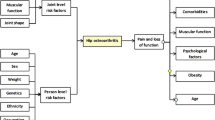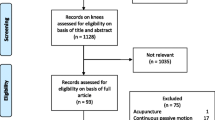Abstract
Introduction
Falls are a major challenge for older people and are a significant source of mortality and morbidity. There has been uncertainty as to whether people with total hip (THA) or knee (TKA) arthroplasty have a greater risk of falls and associated fractures. This analysis was to explore this question with a large community dataset.
Materials and methods
Data from all people enroled onto the US Osteoarthritis Initiative programme who had undergone a THA (n = 104) or TKA (n = 165), within a 12-month period, were compared to those who had not undergone an arthroplasty (n = 4631). Data were collected on: the number of participants who reported a fall within a 12-month period; the frequency of falls in this period; and whether a fracture was sustained during this period. Odd ratios were calculated for the probability of experiencing a fall or fracture between the groups.
Results
There was no statistical difference in falls between people following THA (OR 0.90; 95 % CI 0.58–1.41) or TKA (OR 0.95; 0.67–1.35) compared to a non-arthroplasty cohort. Whilst there was no statistical difference in fracture risk between people following TKA compared to non-arthroplasty individuals (OR 1.25; 95 % CI 0.57–2.70), those who underwent THA had a 65 % lower chance of experiencing a fracture in the initial 12 post-operative months compared to the non-THA cohort (OR 0.35; 95 % CI 0.19–0.65; p < 0.01).
Conclusions
There appears a lower chance of experiencing a fracture for people following THA compared to those who have not.

Similar content being viewed by others
References
Evans D, Pester J, Vera L, Jeanmonod D, Jeanmonod R (2015) Elderly fall patients triaged to the trauma bay: age, injury patterns, and mortality risk. Am J Emerg Med 33:1635–1638. doi:10.1016/j.ajem.2015.07.044
Health Quality Ontario (2008) Prevention of falls and fall-related injuries in community-dwelling seniors: an evidence-based analysis. Ont Health Technol Assess Ser 8:1–78
Do MT, Chang VC, Kuran N, Thompson W (2015) Fall-related injuries among Canadian seniors, 2005–2013: an analysis of the Canadian Community Health Survey. Health Promot Chronic Dis Prev Can 35:99–108
National Clinical Guideline Centre (UK) (2014) Osteoarthritis: care and management in adults. National Institute for Health and Care Excellence (UK), London. https://www.nice.org.uk/Guidance/CG177. Accessed 18 Mar 2016
Culliford D, Maskell J, Judge A, Cooper C, Prieto-Alhambra D, Arden NK, COASt Study Group (2015) Future projections of total hip and knee arthroplasty in the UK: results from the UK Clinical Practice Research Datalink. Osteoarthritis Cartilage 23:594–600
Bade MJ, Kohrt WM, Stevens-Lapsley JE (2010) Outcomes before and after total knee arthroplasty compared to healthy adults. J Orthop Sports Phys Ther 40:559–567
van der Esch M, Holla JF, van der Leeden M, Knol DL, Lems WF, Roorda LD, Dekker J (2014) Decrease of muscle strength is associated with increase of activity limitations in early knee osteoarthritis: 3-year results from the cohort hip and cohort knee study. Arch Phys Med Rehabil 95:1962–1968
Vennu V, Bindawas SM (2014) Relationship between falls, knee osteoarthritis, and health-related quality of life: data from the Osteoarthritis Initiative study. Clin Interv Aging 9:793–800
Doré AL, Golightly YM, Mercer VS, Shi XA, Renner JB, Jordan JM, Nelson AE (2015) Lower-extremity osteoarthritis and the risk of falls in a community-based longitudinal study of adults with and without osteoarthritis. Arthritis Care Res 67:633–639
Gillespie LD, Robertson MC, Gillespie WJ, Sherrington C, Gates S, Clemson LM, Lamb SE (2012) Interventions for preventing falls in older people living in the community. Cochrane Database Syst Rev 9:CD007146
Matsumoto H, Okuno M, Nakamura T, Yamamoto K, Osaki M, Hagino H (2014) Incidence and risk factors for falling in patients after total knee arthroplasty compared to healthy elderly individuals. Yonago Acta Med 57:137–145
Soison A, Riratanapong S, Chouwajaroen N, Chantowart C, Buranapiyawong L, Kaewkot S, Kosuwon W (2014) Prevalence of fall in patients with total knee arthroplasty living in the community. J Med Assoc Thai 97:1338–1343
Ikutomo H, Nagai K, Nakagawa N, Masuhara K (2015) Falls in patients after total hip arthroplasty in Japan. J Orthop Sci 20:663–668
Swinkels A, Allain TJ (2013) Physical performance tests, self-reported outcomes, and accidental falls before and after total knee arthroplasty: an exploratory study. Physiother Theory Pract 29:432–442
Swinkels A, Newman JH, Allain TJ (2009) A prospective observational study of falling before and after knee replacement surgery. Age Ageing 38:175–181
Lalmohamed A, Opdam F, Arden NK, Prieto-Alhambra D, van Staa T, Leufkens HG, de Vries F (2012) Knee arthroplasty and risk of hip fracture: a population-based, case-control study. Calcif Tissue Int 90:144–150
Prieto-Alhambra D, Javaid MK, Maskell J, Judge A, Nevitt M, Cooper C, Arden NK (2011) Changes in hip fracture rate before and after total knee replacement due to osteoarthritis: a population-based cohort study. Ann Rheum Dis 70:134–138
Majewski M, Bischoff-Ferrari HA, Grüneberg C, Dick W, Allum JH (2005) Improvements in balance after total hip replacement. J Bone Joint Surg Br 87:1337–1343
Chang QZ, Sohmiya M, Wada N, Tazawa M, Sato N, Yanagisawa S, Shirakura K (2011) Alternation of trunk movement after arthroplasty in patients with osteoarthritis of the knee. J Orthop Sci 16:382–388
Miki H, Sugano N, Hagio K, Nishii T, Kawakami H, Kakimoto A, Nakamura N, Yoshikawa H (2004) Recovery of walking speed and symmetrical movement of the pelvis and lower extremity joints after unilateral THA. J Biomech 37:443–455
Washburn RA, Smith KW, Jette AM, Janney CA (1993) The Physical Activity Scale for the Elderly (PASE): development and evaluation. J Clin Epidemiol 46:153–162
Levinger P, Menz HB, Wee E, Feller JA, Bartlett JR, Bergman NR (2011) Physiological risk factors for falls in people with knee osteoarthritis before and early after knee replacement surgery. Knee Surg Sports Traumatol Arthrosc 19:1082–1089
Prieto-Alhambra D, Javaid MK, Judge A, Maskel J, Kiran A, de Vries F, Cooper C, Arden NK (2011) Fracture risk before and after total hip replacement in patients with osteoarthritis: potential benefits of bisphosphonate use. Arthritis Rheum 63:992–1001
National Institute for Health and Care Excellence (UK) (2011) The management of hip fracture in adults. (UK), London. https://www.nice.org.uk/Guidance/CG124. Accessed 18 Mar 2016
Lowdon DW, Quinn C, Mole P, Leese GP (2006) Osteoporosis assessment and treatment in older patients who have sustained a hip fracture. Scott Med J 51:32–35
Prieto-Alhambra D, Javaid MK, Judge A, Maskell J, Kiran A, Cooper C, Arden NK (2011) Bisphosphonate use and risk of post-operative fracture among patients undergoing a total knee replacement for knee osteoarthritis: a propensity score analysis. Osteoporos Int 22:1555–1571
de Zwart AH, van der Esch M, Pijnappels MA, Hoozemans MJ, van der Leeden M, Roorda LD, Dekker J, Lems WF, van Dieën JH (2015) Falls associated with muscle strength in patients with knee osteoarthritis and self-reported knee instability. J Rheumatol 42:1218–1223
Muraki S, Akune T, Oka H, Ishimoto Y, Nagata K, Yoshida M, Tokimura F, Nakamura K, Kawaguchi H, Yoshimura N (2013) Physical performance, bone and joint diseases, and incidence of falls in Japanese men and women: a longitudinal cohort study. Osteoporos Int 24:459–466
Shan L, Shan B, Graham D, Saxena A (2014) Total hip replacement: a systematic review and meta-analysis on mid-term quality of life. Osteoarthritis Cartilage 22:389–406
Khatib Y, Madan A, Naylor JM, Harris IA (2015) Do psychological factors predict poor outcome in patients undergoing TKA? A systematic review. Clin Orthop Relat Res 473:2630–2638
Lungu E, Desmeules F, Dionne CE, Belzile EL, Vendittoli PA (2014) Prediction of poor outcomes 6 months following total knee arthroplasty in patients awaiting surgery. BMC Musculoskelet Disord 15:299
Browne JP, Bastaki H, Dawson J (2013) What is the optimal time point to assess patient-reported recovery after hip and knee replacement? A systematic review and analysis of routinely reported outcome data from the English patient-reported outcome measures programme. Health Qual Life Outcomes 11:128
Kennedy DM, Stratford PW, Robarts S, Gollish JD (2011) Using outcome measure results to facilitate clinical decisions the first year after total hip arthroplasty. J Orthop Sports Phys Ther 41:232–239
Acknowledgments
Funding
The OAI is a public–private partnership comprised of five contracts (N01-AR-2-2258; N01-AR-2-2259; N01-AR-2-2260; N01-AR-2-2261; N01-AR-2-2262) funded by the National Institutes of Health, a branch of the Department of Health and Human Services, and conducted by the OAI Study Investigators. Private funding partners include Merck Research Laboratories; Novartis Pharmaceuticals Corporation, GlaxoSmithKline; and Pfizer, Inc. Private sector funding for the OAI is managed by the Foundation for the National Institutes of Health. This manuscript was prepared using an OAI public use data set and does not necessarily reflect the opinions or views of the OAI investigators, the NIH, or the private funding partners.
Author information
Authors and Affiliations
Corresponding author
Ethics declarations
Conflict of interest
None.
Patient consent
Obtained.
Ethics approval
Committee on Human Research, University of California, San Francisco (IRB approval number 10-00532 Approved 10th March 2015).
Electronic supplementary material
Below is the link to the electronic supplementary material.
Rights and permissions
About this article
Cite this article
Smith, T.O., Pearson, M. & Latham, S.K. Are people following hip and knee arthroplasty at greater risk of experiencing a fall and fracture? Data from the Osteoarthritis Initiative. Arch Orthop Trauma Surg 136, 865–872 (2016). https://doi.org/10.1007/s00402-016-2445-5
Received:
Published:
Issue Date:
DOI: https://doi.org/10.1007/s00402-016-2445-5




